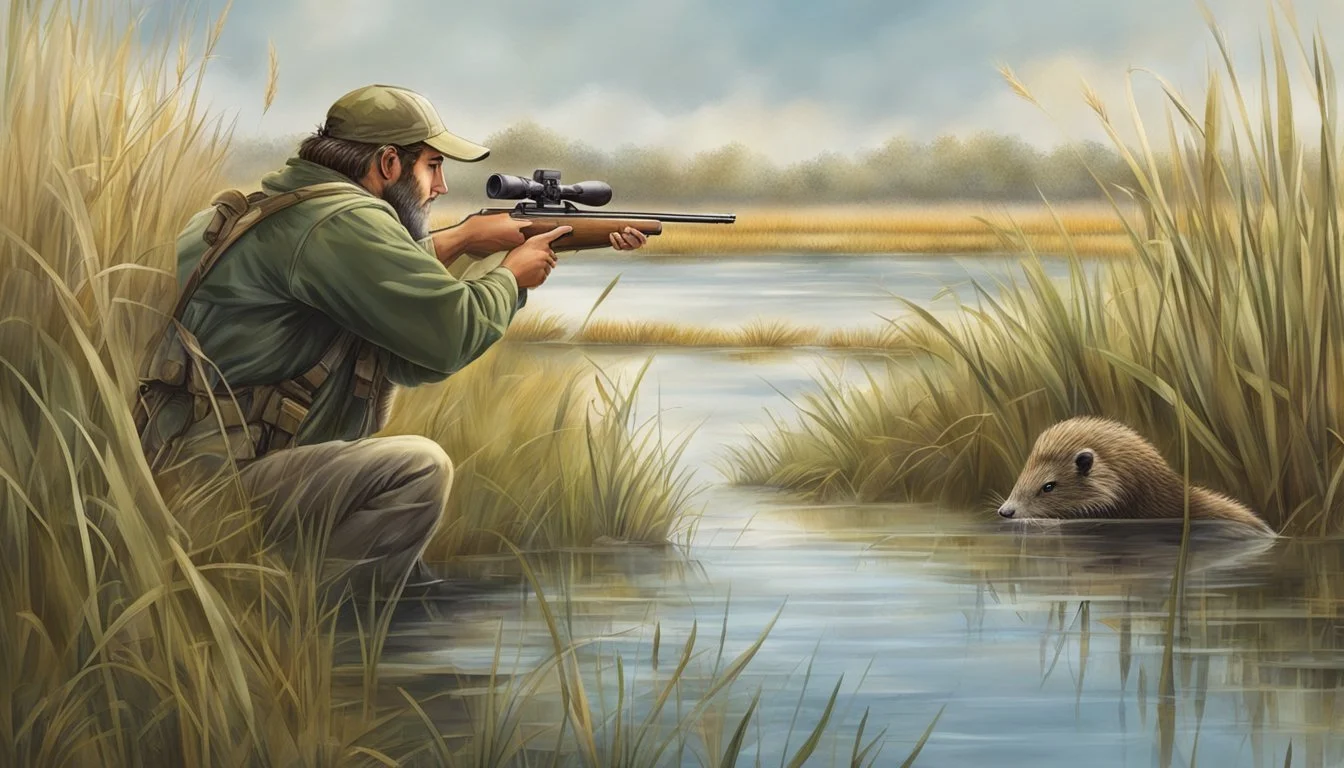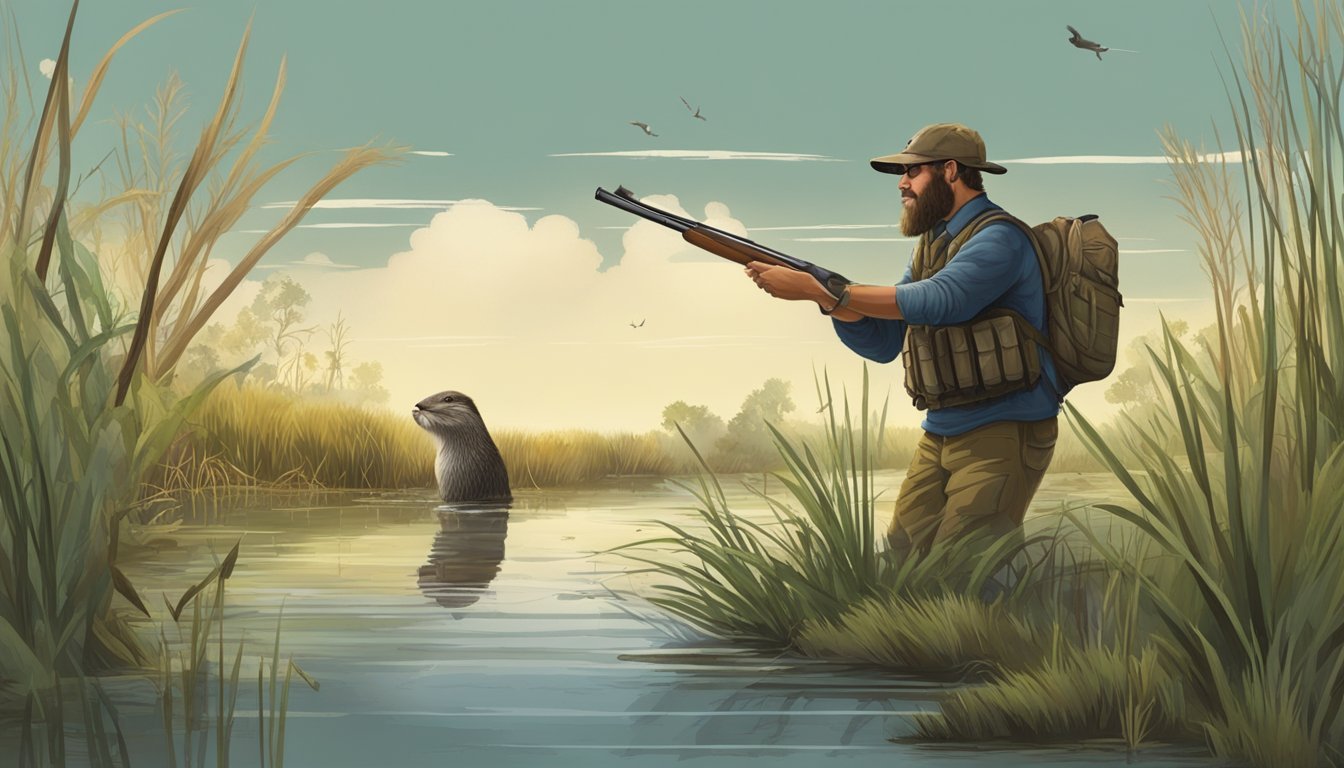Nutria Hunting Seasons
Regulations and Peak Times Across Regions
This Article is Part of Our Guide on Hunting Seasons for Over 70 Common Game Species
Nutria, or coypu, are large semi-aquatic rodents native to South America that have established themselves as an invasive species in the wetlands of Louisiana. Their presence poses a significant threat to the region's ecosystem because they feed on vast amounts of vegetation, destabilizing marshlands crucial for natural flood defences and habitat for other species. To manage the environmental impact of these invasive rodents, Louisiana has implemented regulated nutria hunts. By establishing a hunting season and offering financial incentives to hunters and trappers, the state aims to control the nutria population and mitigate the damage to its vulnerable wetlands.
The Louisiana Wildlife and Fisheries Commission (LWFC) is the body responsible for setting regulations concerning the recreational hunting of nutria, including seasons and bag limits. These measures are part of a broader strategy to manage the state's wildlife resources and ensure the sustainability of its natural habitats. The commission aligns the nutria hunt with other hunting seasons and integrates best practices to promote effectiveness and safety. In doing so, it safeguards the interests of both the environment and the sport hunting community, balancing conservation goals with recreational opportunities.
Understanding Nutria
Nutria are semi-aquatic rodents that have major environmental impacts, particularly in regions such as Louisiana. This species, originally from South America, has become a serious nuisance in wetland habitats.
Species Overview
The nutria, or Myocastor coypus, is a large herbivorous mammal native to South America. These aquatic rodents are characterized by their webbed hind feet, dark brown fur, and long, rounded tails. They are well-adapted to life in water, able to stay submerged for extended periods. Adult nutria can weigh between 12 to 20 pounds, and Louisiana has been a notable hub for their growing population since their introduction in the 1930s.
Size: Typically 12-20 pounds
Habitat: Wetlands, marshes, riverbanks
Origin: South America
Introduction to Louisiana: 1930s
Physical Traits: Webbed hind feet, brown fur, long tails
Environmental Impact
Nutria feed on the roots of wetland plants, which is critical to the integrity and sustainability of marsh ecosystems. Their feeding habits can lead to significant marsh damage, contributing to erosion and weakening levee systems that are crucial for flood protection. The degradation of coastal wetlands due to nutria is a pressing environmental concern, as these habitats protect against storm surges and support a diverse range of species.
Diet: Plant roots, stems
Erosion: Weakens wetland root systems
Levee Damage: Increases flood risk
Nutria as Nuisance
Invasive species like nutria, also referred to as swamp rats, pose a serious nuisance to the ecosystems they inhabit. Their burrowing behaviors have severe consequences for wetland durability and they have been known to damage agricultural crops as well. Effective management and control of the nutria population is necessary to mitigate the extensive wetland damage in areas such as Louisiana's coastal regions.
Burrowing Habits: Undermine wetland stability
Agricultural Damage: Crop destruction
Status: Invasive species
Control Measures: Hunting, population management
Regulations and Conservation
This section outlines the specifics of the legal framework governing nutria hunting and the conservation efforts in place to manage the species effectively.
Hunting Regulations
The Louisiana Wildlife and Fisheries Commission (LWFC) mandates a set of regulations to ensure sustainable hunting practices. For nutria, these include:
Designated hunting seasons: The season during which hunters can legally pursue nutria.
Bag limits: A cap on the number of nutria that can be taken by an individual to prevent overharvesting.
Required licenses: Prospective hunters need appropriate hunting or trapping licenses to target nutria.
Landowners may also grant permission for nutria hunting on their private property, aiding in the species’ management. All regulations and updates are available on the Louisiana Department of Wildlife and Fisheries (LDWF) website, ensuring hunters have access to the most recent information.
Conservation Programs
Nutria control is crucial for protecting Louisiana's wetlands. The LDWF and the Louisiana Wildlife Federation engage in:
Nutria Control Program: A management plan that helps preserve the ecosystem by controlling the invasive nutria population.
Collaborative efforts with Wildlife Management Areas (WMAs): These serve as regulated environments where nutria and other wildlife are managed in accordance with conservation goals.
Conservation programs are supported by the application of hunting regulations, thereby aligning the sportsmen's activities with ecological preservation initiatives. Moreover, the LDWF actively works with various stakeholders, including landowners and conservation groups, to establish effective strategies for wildlife management.
Hunting Seasons and Techniques
This section provides detailed information on the regulated hunting seasons, effective methods of hunting, and the requisite licenses and permits for hunting nutria.
Season Dates and Limits
Nutria can be hunted throughout the year in Louisiana, as they are considered an invasive species. However, the state may designate specific recreational hunting seasons in order to manage the population more effectively. During these designated seasons, the Louisiana Wildlife and Fisheries Commission (LWFC) sets season dates, daily bag, and possession limits. Recreational hunters should check the latest regulations for the current season's dates and limits.
Hunting Methods
Nutria are typically hunted using firearms such as rifles and shotguns. Hunters commonly employ airboats for accessibility and to cover the diverse terrains where nutria are found, including marshes and wetlands. Trapping is another effective technique used, which might be subject to different regulations than hunting with firearms. When hunting, aim for precision to ensure a quick and ethical harvest.
Licenses and Permits
Hunting licenses are mandatory for nutria hunting. Specifics depend on whether the hunter is a resident or non-resident of Louisiana, and fees vary accordingly. A basic hunting license is required and, in some cases, additional trapping licenses may also be necessary, especially if the hunting involves the use of traps. It is important to note that hunting on federal lands or private land may require additional permits or permissions from the landowner. Always ensure compliance with all local, state, and federal regulations before planning your hunting trip.
Nutria Harvesting
Nutria, large semi-aquatic rodents, have become a notable target for both their fur and meat. Efficient harvesting is aided by bounties on tails and the creatures' culinary potential, marking an intersection of control measures and resource utilization.
Culinary Uses
The meat of nutria is considered a sustainable source of protein and is traditionally prepared in various ways. It can be deep-fried, akin to chicken, or stewed for a heartier meal. Nutria meat, also dubbed table fare, is often described as having a taste comparable to rabbit or wild fowl, positioning it as a viable option for adventurous eaters.
Deep-fried nutria: A crispy exterior with tender meat inside.
Stewed nutria: Slow-cooked to bring out a richer flavor.
Fur Trade History
The fur trade once flourished with nutria as a central commodity. Originating from fur farming in Louisiana during the 1930s, nutria fur was significantly valued for its warmth and texture. However, the demand has since diminished, leading to a current focus on their harvesting primarily for ecological management purposes.
Peak of fur trade: 1930s Louisiana.
Current status: Reduced demand, with emphasis on population control.
Additional Information
This section offers insights into the hunting seasons for various species, the regulations that hunters must adhere to, and the involvement of stakeholders in managing and controlling the nutria population.
Related Hunting Seasons
Hunting seasons in Louisiana are diverse and regulated by the Louisiana Department of Wildlife and Fisheries (LDWF) to balance wildlife populations and hunter opportunities. The common hunting seasons include:
Deer: Archery seasons typically range from October to January, with Area A having a longer season.
Ducks and Dove: Fall seasons, with ducks also having a spring conservation order for light geese.
Turkey: Spring season, generally kicking off in April.
Small Game: Squirrel and rabbit seasons that often open in the fall.
Furbearers: Raccoon, opossum, and others, with specific night hunting periods.
Legal and Ethical Considerations
Hunters are expected to follow strict laws and guidelines for a sustainable and ethical hunting experience:
Bag Limits: Daily and seasonal bag limits are established for species like deer, dove, and ducks.
Licenses and Permits: Mandatory to carry the appropriate licenses and permits issued by the LDWF.
Hunter Education: Required for all new hunters to ensure they understand wildlife conservation, safe firearm use, and hunter responsibility.
Property Rights: Hunters must respect private lands and secure permission to hunt.
Stakeholder Initiatives
Multiple initiatives aim to balance the interests of landowners, hunters, and conservationists:
Nutria Control Program: The LDWF provides incentives to reduce the nutria population due to its impact on the coastal marshes.
Youth Hunts: Special hunting dates to engage and educate young hunters.
Habitat Conservation: Initiatives like the Atchafalaya Delta Wildlife Management Area's management support diverse species, including wood ducks and nutria.
Research and Management: Studies to address the ecological impact of invasive species like hogs and nutrias in the United States.
By understanding these additional details, hunters can fully prepare for the hunting season, ensuring compliance with the regulations and contributing to the conservation efforts in Louisiana.




